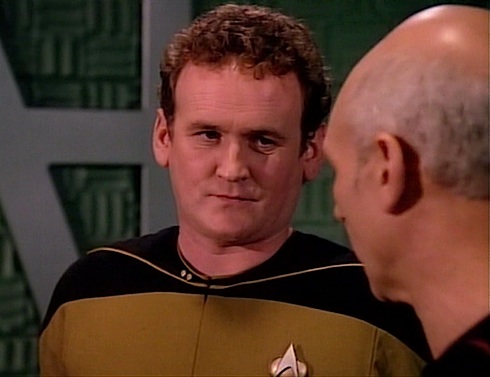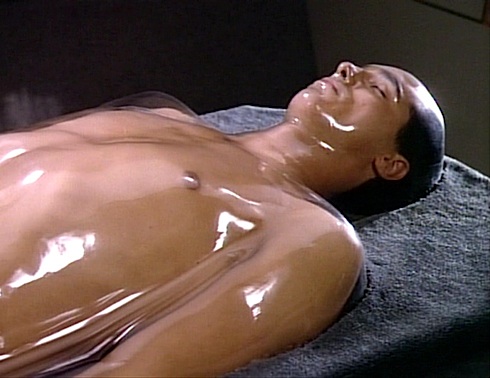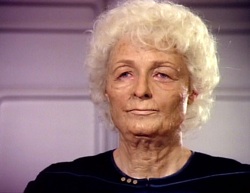“Unnatural Selection”
Written by John Mason & Mike Gray
Directed by Paul Lynch
Season 2, Episode 7
Production episode 40272-133
Original air date: January 30, 1989
Stardate: 42494.8
Captain’s Log: The Enterprise picks up a distress call from the U.S.S. Lantree. The captain, Telaka, says that they’re dying. The Enterprise moves to intercept, but they find no life signs. Remote access to the ship reveals a bridge full of old, decrepit corpses. Pulaski’s scan reveals that they died of natural causes, and Riker points out that he and Telaka were the same age.
The Lantree‘s last port of call was Darwin Station on Gagarin IV. Upon arrival, the crew is told that they’re suffering a similar fate—Dr. Kingsley, who answers the call, looks to be in her 50s, but is only 35.
She insists that their children must be evacuated, as they aren’t showing symptoms, but Picard is reluctant to do so, especially since Pulaski wishes to quarantine Gagarin IV. The children, who are part of the genetic experiments being done on Darwin Station, are the pride and joy of Kingsley and the other scientists. They beam up one of those children encased in styrolite and in stasis. Though he is supposed to be twelve years old, Troi can sense his presence even in stasis, and he also appears to be fully mature.
Pulaski wishes to examine him further out of the styrolite, but Picard isn’t convinced that it can be done under safe conditions. At La Forge’s suggestion, Pulaski takes the boy onto a shuttlecraft—piloted by Data, who would likely not be affected by the disease—and examines him after removing the styrolite.
After being with the child for twenty minutes, Pulaski suffers an arthrtitc cramp—the initial symptom of the disease. The children are, in fact, carriers of the disease. Pulaski gets the disease and starts aging—which means she gets dipped in the most latex I’ve seen since Admiral Jameson.
Picard comes up with a technobabble solution to the disease involving running Pulaski through the transporter, and he operates the transporter himself, since if it doesn’t work, they can’t transport her back.
But, of course, it works because, well, this is television. After the adults of Darwin Station are restored, the Enterprise returns to the Lantree and scuttles her.

Can’t We Just Reverse the Polarity?: Chief O’Brien suggests using the transporter trace to use as a guide to reconstitute Pulaski. Since the biofilter doesn’t work on the disease, he suggests using the trace. However, Pulaski has never taken the transporter, so they have no trace to work with—until they use a hair from her hairbrush. O’Brien comes up with a ton of technobabble to explain how difficult it will be to modify the transporter, involving terms like biofilter bus, molecular matrix reader, waveform modulator, regeneration limiter, first-stage circuit, and Illudium Q-36 Explosive Space Modulator. (I may have made that last one up). Regardless, he can do it. Because he’s just that awesome.
Thank You, Counselor Obvious: Troi does her usual “she’s hiding something” routine with Dr. Kingsley, and she gets to be the recipient of Pulaski and Picard going all he-said-she-said. She also figures out that the genetically engineered kids are telepathic. Because she’s just that awesome.
If I Only Had a Brain…: Data determines how the children are the ones responsible for the disease. Because he’s just that awesome.
I’m a Doctor, Not an Escalator. We get all of Pulaski’s worst traits in this episode: her stubbornness, her intensity, her constant interrupting of people, her bitching out Data (though at least this time she apologizes to him when he expresses concern over her health), and we get an added bonus: transporter-phobia, because apparently she wasn’t enough like Dr. McCoy yet. To make matters worse, Pulaski is wholly incompetent in this episode. She insists on examining the child outside of stasis, a bull-headed move that nearly kills her. It’s Data who figures out what happened, and O’Brien and Picard who come up with the solution.

We also learn from her previous CO, Captain Taggart, that she requested the transfer to the Enterprise, and knows Picard’s service record backward and forwards. You’d think, given that, she wouldn’t interrupt him so much….
Her snarking of Data continues, even though she pretty much relies on him all throughout, arrogantly pointing out that taking risks is something humans do that he wouldn’t understand and chiding him for his lousy bedside manner—though she does have the good grace to apologize at one point. All it does is make the character look bad. McCoy’s snarking of Spock was mainly because McCoy was trying to get Spock to admit to his human half; Spock also gave as good as McCoy got. Pulaski going after Data, however, is not the same thing because he’s not denying half his heritage, he simply is what he is, and is actually trying to be more. Pulaski picking on Data is very much like kicking a puppy, and nobody wants to see their heroes doing that.
Welcome Aboard. After showing up three times in the first season and appearing as the transporter operator a few times this season, Colm Meaney gets a last name (O’Brien) and a substantial supporting role, as he is instrumental in saving Pulaski. Patricia Smith is dreadful as the snotty, stubborn, arrogant Dr. Kingsley. J. Patrick McNamara makes an entertaining cameo as Taggart.
I Believe I Said That: “And Doctor? God knows, I’m not one to discourage input. But I would appreciate it if you’d let me finish my sentences once in a while.”
Picard, putting Pulaski in her place.

Trivial Matters: Besides providing O’Brien with a name, and setting the stage for his future career as the miracle worker on Deep Space Nine, this episode also marks the one and only time humans are seen performing legal genetic engineering, since it will later be established that genetically engineering humans is illegal in the Federation—a state of affairs at odds with this episode, but what can you do?
Make it so. “Not exactly up to factory specs.” A warmed-over rehash of the original seriers’ “The Deadly Years,” without even the fun of having a cool Walter Koenig girly-scream. Bad enough that this is an episode that focuses on Pulaski that mostly makes her look like an idiot, it also gives us the lamest of technobabble solutions: the transporter fixes it!
The episode does give us a new recurring character—yet another example of the second season trying to expand the crew of the Enterprise, as with Selar last week—and O’Brien would become one of the most popular supporting characters on the show, and later becoming a regular on the first spinoff.
It’s just a pity it happened in this dreadful episode. Leaving aside the inherent doofiness of an “old-age virus,” this episode is a smorgasbord of many of TNG‘s worst qualities, down to the technobabble solution and the ineffectiveness of every character not named Picard or Data.
Worse, it reinforces Pulaski’s status as a lame McCoy clone thanks to her transporter phobia, and also reinforces the character’s inability to problem-solve. Not once in the entire season do we see the character does she ever actually research and come up with a solution. She either instantly knows the answer or never does—this episode is a prime example, as she never figures anything out, and gives herself a potentially fatal illness while not doing so.
I will, however, give them points for the scuttling of the Lantree at the end of the episode, which was handled with dignity and respect.

Warp factor rating: 3
Keith R.A. DeCandido got to write the character of O’Brien in his short story “Broken Oaths” in the Star Trek: Deep Space Nine anthology Prophecy and Change, one of his many many many pieces of Trek fiction. His latest books include the fantastical police procedurals Unicorn Precinct and SCPD: The Case of the Claw. He’s working on sequels to both books for 2012 release: Goblin Precinct and SCPD: Avenging Amethyst. For more about Keith, go to his web site, from which you can order his latest books, and check out his blog, his Facebook page, and his Twitter feed, not to mention his twice-monthly podcast Dead Kitchen Radio.










